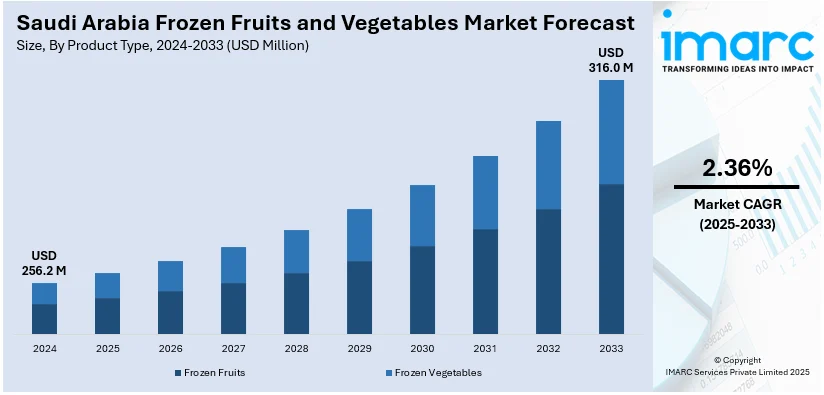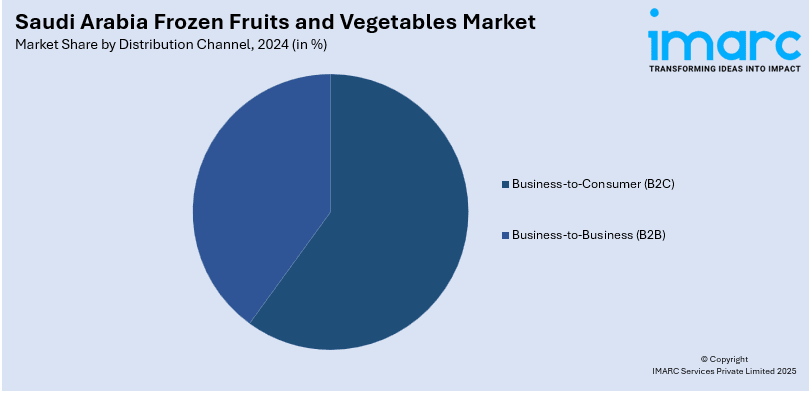
Saudi Arabia Frozen Fruits and Vegetables Market Size, Share, Trends and Forecast by Product Type, Distribution, and Region, 2025-2033
Saudi Arabia Frozen Fruits and Vegetables Market Overview:
The Saudi Arabia frozen fruits and vegetables market size reached USD 256.2 Million in 2024. Looking forward, IMARC Group expects the market to reach USD 316.0 Million by 2033, exhibiting a growth rate (CAGR) of 2.36% during 2025-2033. The market is driven by rising demand for convenient, healthy food options, supported by busy lifestyles and modern retail expansion. Growth in the food service and hospitality sector, fueled by tourism and major events, also enhances demand. Government health initiatives and reduced food waste are further expanding the Saudi Arabia frozen fruits and vegetables market share.
|
Report Attribute
|
Key Statistics
|
|---|---|
|
Base Year
|
2024
|
|
Forecast Years
|
2025-2033
|
|
Historical Years
|
2019-2024
|
| Market Size in 2024 | USD 256.2 Million |
| Market Forecast in 2033 | USD 316.0 Million |
| Market Growth Rate 2025-2033 | 2.36% |
Saudi Arabia Frozen Fruits and Vegetables Market Trends:
Increasing Demand for Healthy and Convenient Food Options
The market is experiencing significant growth due to the rising consumer demand for healthier and on-the-go food solutions. With lifestyles becoming more demanding and the number of working professionals on the rise, consumers have increasingly turned to nutritious alternatives to fresh produce that offer long shelf life and can easily be prepared with minimum effort. According to Saudi Arabia's labor statistics for Q4 2024, the employment rate stands at 66.4%. The employment rate for Saudi women was 36.0%, compared to 27.9% for non-Saudi women. Meanwhile, the employment rates of Saudi men and non-Saudi men were 66.2% and 93.2%, respectively. Thus, this is positively influencing Saudi Arabia frozen fruits and vegetables market growth. Preserving essential vitamins and minerals, frozen fruits and vegetables are an advantageous choice for health-conscious individuals. Additionally, the emergence of modern retail formats, such as hypermarkets and online grocery services, has further improved the accessibility of frozen food products. This trend is also supported by government initiatives that focus on promoting healthy eating habits, including reducing food waste and encouraging balanced and well-adjusted diets. As a result, the market is witnessing new launches of frozen products, including organic food and exotic fruits, to cater to changing consumer preferences, propelling the market.

Growth in the Food Service and Hospitality Sector
The growing food service and hospitality sector in Saudi Arabia significantly contributes to the frozen fruits and vegetables market. The flourishing tourism industry, along with prominent events, is boosting the need for premium, ready-to-use food ingredients in hotels, restaurants, and catering establishments. In 2023, Saudi Arabia surpassed 100 million tourists, reaching this landmark seven years ahead of its expectations. Tourism contributed 4.4% of the country's GDP in 2019, with an expenditure of SAR 255.6 Billion (approximately USD 69.01 Billion). International tourism achieved 27.4 million visitors, covering SAR 141.2 Billion (approximately USD 38.12 Billion), and domestic tourism is attracting 81.9 million residents. This influx in tourism is increasing the demand for different industries, including the frozen fruits and vegetable industry, thus supporting the hospitality and retail industry across the country. Frozen fruits and vegetables provide an affordable option with availability year-round, reducing reliance on seasonal foods and minimizing the effects of breaks in the supply chain. Moreover, the growth of interest in global cuisines has led to a rise in the utilization of frozen items in the food service channel for homogeneity and to maximize the efficiency of meal preparation. With Saudi Arabia’s Vision 2030 emphasizing economic diversification and tourism growth, the food service industry is expanding further, creating a positive Saudi Arabia frozen fruits and vegetables market outlook.
Saudi Arabia Frozen Fruits and Vegetables Market Segmentation:
IMARC Group provides an analysis of the key trends in each segment of the market, along with forecasts at the country level for 2025-2033. Our report has categorized the market based on product type and distribution.
Product Type Insights:
- Frozen Fruits
- Frozen Vegetables
The report has provided a detailed breakup and analysis of the market based on the product type. This includes frozen fruits and frozen vegetables.
Distribution Insights:

- Business-to-Consumer (B2C)
- Supermarkets/Hypermarkets
- Independent Retailers
- Convenience Stores
- Online
- Others
- Business-to-Business (B2B)
A detailed breakup and analysis of the market based on the distribution have also been provided in the report. This includes business-to-consumer (B2C) (supermarkets/hypermarkets, independent retailers, convenience stores, online, and others), and business-to-business (B2B)
Regional Insights:
- Northern and Central Region
- Western Region
- Eastern Region
- Southern Region
The report has also provided a comprehensive analysis of all the major regional markets, which include Northern and Central Region, Western Region, Eastern Region, and Southern Region.
Competitive Landscape:
The market research report has also provided a comprehensive analysis of the competitive landscape. Competitive analysis such as market structure, key player positioning, top winning strategies, competitive dashboard, and company evaluation quadrant has been covered in the report. Also, detailed profiles of all major companies have been provided.
Saudi Arabia Frozen Fruits and Vegetables Market News:
- December 06, 2024: Americana and Farm Frites are investing a total of USD 100 million (SR 375 million) to build a state-of-the-art Frozen French Fries manufacturing plant in Riyadh, expected to be operational in 2026, with a designed production capacity of 70,000 metric tons/year. It is situated on more than 100,000 square meters in Sudair Industrial and Business City, and the project aligns with domestic agricultural efforts under Saudi Vision 2030. This initiative is aligned with the rapid growth of Saudi Arabia's frozen fruits and vegetables sector, strengthening regional supply chains and improving food security.
Saudi Arabia Frozen Fruits and Vegetables Market Report Coverage:
| Report Features | Details |
|---|---|
| Base Year of the Analysis | 2024 |
| Historical Period | 2019-2024 |
| Forecast Period | 2025-2033 |
| Units | Million USD |
| Scope of the Report |
Exploration of Historical Trends and Market Outlook, Industry Catalysts and Challenges, Segment-Wise Historical and Future Market Assessment:
|
| Product Types Covered | Frozen Fruits, Frozen Vegetables |
| Distribution Covered |
|
| Regions Covered | Northern and Central Region, Western Region, Eastern Region, Southern Region |
| Customization Scope | 10% Free Customization |
| Post-Sale Analyst Support | 10-12 Weeks |
| Delivery Format | PDF and Excel through Email (We can also provide the editable version of the report in PPT/Word format on special request) |
Key Questions Answered in This Report:
- How has the Saudi Arabia frozen fruits and vegetables market performed so far and how will it perform in the coming years?
- What is the breakup of the Saudi Arabia frozen fruits and vegetables market on the basis of product type?
- What is the breakup of the Saudi Arabia frozen fruits and vegetables market on the basis of distribution?
- What is the breakup of the Saudi Arabia frozen fruits and vegetables market on the basis of region?
- What are the various stages in the value chain of the Saudi Arabia frozen fruits and vegetables market?
- What are the key driving factors and challenges in the Saudi Arabia frozen fruits and vegetables market?
- What is the structure of the Saudi Arabia frozen fruits and vegetables market and who are the key players?
- What is the degree of competition in the Saudi Arabia frozen fruits and vegetables market?
Key Benefits for Stakeholders:
- IMARC’s industry report offers a comprehensive quantitative analysis of various market segments, historical and current market trends, market forecasts, and dynamics of the Saudi Arabia frozen fruits and vegetables market from 2019-2033.
- The research report provides the latest information on the market drivers, challenges, and opportunities in the Saudi Arabia frozen fruits and vegetables market.
- Porter's five forces analysis assist stakeholders in assessing the impact of new entrants, competitive rivalry, supplier power, buyer power, and the threat of substitution. It helps stakeholders to analyze the level of competition within the Saudi Arabia frozen fruits and vegetables industry and its attractiveness.
- Competitive landscape allows stakeholders to understand their competitive environment and provides an insight into the current positions of key players in the market.
Need more help?
- Speak to our experienced analysts for insights on the current market scenarios.
- Include additional segments and countries to customize the report as per your requirement.
- Gain an unparalleled competitive advantage in your domain by understanding how to utilize the report and positively impacting your operations and revenue.
- For further assistance, please connect with our analysts.
 Request Customization
Request Customization
 Speak to an Analyst
Speak to an Analyst
 Request Brochure
Request Brochure
 Inquire Before Buying
Inquire Before Buying




.webp)




.webp)












